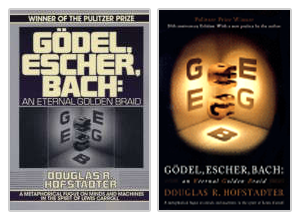Douglas Hofstadter

College Professor of Cognitive Science and Computer Science; Adjunct Professor of History and Philosophy of Science, Philosophy, Comparative Literature, and Psychology Ph.D. in physics, University of Oregon, 1975; Pulitzer Prize (General Nonfiction category), 1980, American Book Award (Science Hardback category), 1980, for Gödel, Escher, Bach: an Eternal Golden Braid; Guggenheim Fellow, 1980-81.

Research Interests
Douglas Hofstadter is College Professor of cognitive science and computer science, director of the Center for Research on Concepts and Cognition, and adjunct professor of philosophy, psychology, history and philosophy of science, and comparative literature. His Pulitzer-prize-winning book Godel, Escher, Bach: an Eternal Golden Braid (1979) has had considerable impact on people in many disciplines, ranging from philosophy to mathematics to artificial intelligence to music, and beyond. He has written several other books and many articles, and for a number of years wrote a column for Scientific American.
Hofstadter’s research is driven by a long-standing interest in creativity and consciousness. To study these abstract ideas in a concrete manner, he has focused on designing and implementing, in collaboration with his graduate students, computer models of high-level perception and analogical thought in carefully-designed idealized domains.
Several programs that perceive structures and discover subtle as well as simple analogies by means of a tight interplay between concepts in long-term memory and perceptual agents in short-term memory have been realized over the years; these include Copycat and Tabletop. The Letter Spirit project, modeling the perception and creation of diverse artistic styles, has been under way for several years, and a first implementation has recently been completed. The Metacat project, which deepens Copycat by bringing in episodic memory and some degree of self-awareness, has also been implemented in a preliminary fashion.
Hofstadter also studies and writes about cognitive phenomena in a number of other areas. Some of these are: the relationship between words and concepts; the mechanisms underlying human error-making, especially in language; the nature of sexist language and default imagery; the mechanisms underlying discovery and invention in mathematics, especially geometry; the process of creative literary translation, especially of poetry; the challenge of sorting the wheat from the chaff in AI and cognitive science; and the philosophy of mind, consciousness, and the sense of self.
Facilities
Center for Research on Concepts and Cognition, 510 North Fess Avenue Representative Publications
Hofstadter, D. R., Goedel, Escher, Bach: an Eternal Golden Braid, NY: Basic Books, 1979.
Hofstadter, D. R., The Mind’s I: Fantasies and Reflections on Self and Soul, together with Daniel C. Dennett, (Eds.), NY: Basic Books, 1981.
Hofstadter, D. R., Metamagical Themas: Questing for the Essence of Mind and Pattern, NY: Basic Books, 1985.
Hofstadter, D. R., Ambigrammi: un microcosmo ideale per lo studio della creativita, Florence, Italy: Hopeful Monster, 1987.}
Hofstadter, D. R., Fluid Concepts and Creative Analogies: Computer Models of the Fundamental Mechanisms of Thought, (together with the Fluid Analogies Research Group), NY: Basic Books, 1995.
Hofstadter, D. R., Le Ton beau de Marot: In Praise of the Music of Language, NY: Basic Books, 1997.
Hofstadter, D. R., translation of Pushkin’s novel in verse “Eugene Onegin”, NY: Basic Books, 1999.
Hofstadter, D. R., Speechstuff and thoughtstuff: Musings on the resonances created by words and phrases via the subliminal perception of their buried parts. In Sture Allen (ed.), Of Thoughts and Words: The Relation between Language and Mind. Proceedings of the Nobel Symposium 92, 1995, London/New Jersey: World Scientific Publ., 217-267.
Hofstadter, D. R., On seeing A’s and seeing As. Stanford Humanities Review 4,2 (1995) pp. 109-121.
Research Projects:
A self-watching cognitive architecture for analogy-making. The Metacat project is an attempt to computationally model certain key aspects of human cognition. It has its foundations in an earlier project called Copycat, a computer model of high-level perception and analogy-making. The central theme underlying Copycat is the idea of nondeterministic, stochastic processing distributed among a large number of small computational agents, which work on different aspects of an analogy problem simultaneously, at different speeds, thereby achieving a kind of differential parallelism. All processing occurs through the collective actions of many agents working together, without any higher-level, executive process directing the overall course of events. Thus, Copycat lies firmly within the paradigm of emergent computation. At the same time, however, it incorporates many ideas from the more traditional paradigm of symbolic AI, inhabiting a kind of middle ground between these two opposites. Current research is concerned with extending the model in a way that will allow it to create much richer representations of the analogies it makes. This involves the idea of ‘self-watching’ — the ability to perceive and remember patterns that occur in its own processing as it solves analogy problems. Based on this ability, Metacat will be able to understand and explain its answers in a way that Copycat cannot, and will eventually be able to perceive analogies between analogies.
Recent References:
Hofstadter, D. R., and Marshall, J. B. D. A Self-Watching Cognitive Architecture of High-Level Perception and Analogy-Making. TR 100, Indiana University Center for Research on Concepts and Cognition, 1993.
Marshall, J. B. D., and Hofstadter, D. R., Beyond copycat: Incorporating self-watching into a computer model of high-level perception and analogy-making, In M.Gasser (ed.), Online Proceedings of the 1996 Midwest Artificial Intelligence and Cognitive Science Conference. URL https://www.cs.indiana.edu/event/maics96/Proceedings/ Marshall/marshall.html
Hofstadter, D. R., and Marshall, J. B. D. From Copycat to Metacat: Developing a Self-Watching Framework for Analogy-Making. TR 115, Indiana University Center for Research on Concepts and Cognition, 1997. To appear in Tony Veale (Ed.), Proceedings of the Mind II: Computational Models of Creative Cognition Conference, Dublin City University, Dublin, Ireland, 1997.
An emergent model of the perception and creation of alphabetic style. This project is an attempt to model central aspects of human high-level perception and creativity on a computer. It is based on the belief that creativity is an automatic outcome of the existence of sufficiently flexible and context-sensitive concepts—what we call fluid concepts. Accordingly, our goal is to implement a model of fluid concepts in a challenging domain. Not surprisingly, the Letter Spirit project is a very complex undertaking and requires complex dynamic memory structures, as well as a sophisticated control structure based on the principles of emergent computation, wherein complex high-level behavior emerges as a statistical consequence of many small computational actions. The full realization of such a model will, we believe, shed light on the mechanisms of human creativity.
The specific focus of Letter Spirit is the creative act of artistic letter-design. The aim is to model how the 26 lowercase letters of the roman alphabet can be rendered in many different but internally coherent styles. The program addresses two important aspects of letterforms: the categorical sameness possessed by letters belonging to a given style ( e.g., Helvetica). Starting with one or more seed letters representing the beginnings of a style, the program will attempt to create the rest of the alphabet in such a way that all 26 letters share that same style, or spirit.
Recent References:
Collaborators: Gary McGraw, John Rehling and Robert Goldstone. Letter perception: Toward a conceptual approach, in Proceedings of the Sixteenth Annual Conference of the Cognitive Science Society, Atlanta, 1994, pp. 613-618.
McGraw, G., and Hofstadter, D. R. Letter spirit: An architecture for creativity in a microdomain. In P. Torasso (ed.), { Advances in Artificial Intelligence: Lecture Notes in Artificial Intelligence}, Springer Verlag, 1994, pp. 65-70.
McGraw, G., and Hofstadter, D. R. Perception and creation of diverse alphabetic style. In AISB Quarterly — Newsletter of the Society for the Study of Artificial Intelligence and Simulation of Behaviour, Special Theme: AI and Creativity, Guest-Editor: Terry Dartnall, Autumn 1993, No. 85, University of Sussex, UK, pp. 42-49.
Gary E. McGraw, Jr. Letter Spirit (Part One): Emergent High-level Perception of Letters Using Fluid Concepts. Ph.D. Thesis, Indiana University, 1995.
Rehling, J. and Hofstadter, D. R. Letter Spirit: Automating Creative Design. TR 116, Indiana University, Center for Research on Concepts and Cognition. To appear in Tony Veale Ed., Proceedings of the Mind II: Computational Models of Creative Cognition Conference, Dublin City University, Dublin, Ireland. 1997.
Rehling, J. and Hofstadter, D.R. The Parallel Terraced Scan: An Optimization for an Agent-Oriented Architecture. TR 114, Indiana University, Center for Research on Concepts and Cognition. In Proceedings of the IEEE International Conference on Intelligent Processing Systems 1997, Beijing, China. 1997.
Phone: (812) 855-6965
Internet: dughof@cogsci.indiana.edu
